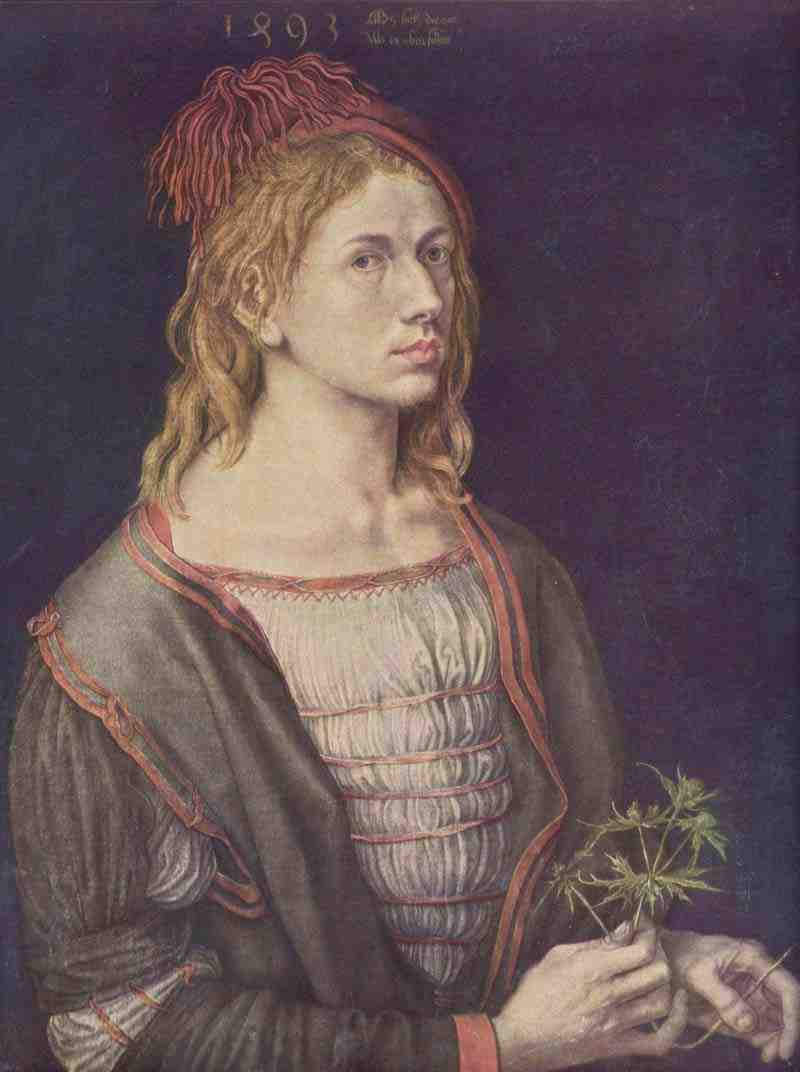
Self-Portrait. Albrecht Dürer
1493 canvas, 57 × 45 cm
Paris, Musée du Louvre
----
Selbstporträt. Albrecht Dürer
1493, Leinwand, 57 × 45 cm
Paris, Musée du Louvre
---
----
Fine Art Prints | Greeting Cards | Phone Cases | Lifestyle | Face Masks | Men's , Women' Apparel | Home Decor | jigsaw puzzles | Notebooks | Tapestries | ...
----
Albrecht Dürer: Watercolours and Drawings, John Berger
Albrecht Dürer's Renaissance: Humanism, Reformation, and the Art of Faith, David Price
Albrecht Dürer and the Venetian Renaissance, Katherine Crawford Luber
Portrait of the Artist Holding a Thistle (or Eryngium) is an oil painting on parchment pasted on canvas by German artist Albrecht Dürer, painted in 1493. It is the earliest of Dürer's painted self-portraits and has been identified as one of the first self-portraits painted by a Northern artist.[1] It is currently held and exhibited at the Louvre in Paris.
History
The date, and the plant in the artist's hand, seem to suggest that this is a betrothal portrait (Brautporträt). Dürer has in fact depicted himself in the act of offering a flowering spray identified by botanists as eryngium amethystinum: its German name is "Mannestreue", meaning conjugal fidelity. Resembling the thistle (from which the portrait's title), this umbelliferous plant is used in medicine, and is regarded as an aphrodisiac.[2] It may also have religious significance; the same plant in outline form is inscribed in the gold ground of Dürer's painting Christ as the Man of Sorrows (1493–94).[3]
In 1493, Dürer was 22 years old and working in Strasbourg. He had completed his apprenticeship with Michael Wolgemut and his tour as a journeyman, and would marry Agnes Frey on 7 July 1494.[3]
Dürer was temperamentally inclined to philosophical doubts. He often analysed his own face in drawn or painted effigies – sometimes idealizing it, sometimes not. The lines written beside the date in this painting reveal the philosophical and Christian intention of the work:
Myj sach die gat
Als es oben schtat.
in other words (and liberally): My affairs follow the course allotted to them on high. Marriage has in part determined his destiny – the Bridegroom puts his future life in the hands of God.[4]
In 1805, Goethe saw a copy of this portrait in the museum at Leipzig and wrote of it:
I thought Albrecht Dürer's self-portrait, dated 1493, to be of inestimable value.[5]
According to Lawrence Gowing, who calls this "the most French of all his pictures", the Portrait of the Artist Holding a Thistle is singular among Dürer's paintings as "the touch is freer and color more iridescent than in any other picture one remembers".[6]
The painting was purchased by the Louvre in 1922.[6]
Notes
Fenyő, Iván (1956). Albrecht Dürer. Budapest: Corvina. p. 16.
Botanical herbal note on the eryngium, on Botanical.com. Accessed 13 January 2012
Wolf, Norbert (2006). Albrecht Dürer. Köln: Taschen. p. 28.
J.L. Koerner, The Moment of Self-portraiture in German Renaissance Art, University of Chicago Press (1997).
H. von Einem, Goethe und Dürer - Goethes Kunstphilosophie, Hamburg: von Schröder (1947).
Gowing, Lawrence (1987). Paintings in the Louvre New York: Stewart, Tabori & Chang. p. 164. ISBN 1-55670-007-5
References
Bailey, Martin. Dürer. London: Phaidon Press, 1995. ISBN 0-7148-3334-7
Brion, Marcel. Dürer. London: Thames and Hudson, 1960.
Bartrum, Giulia. Albrecht Dürer and his Legacy. British Museum Press, 2002. ISBN 0-7141-2633-0
Campbell Hutchison, Jane. Albrecht Dürer: A Biography. Princeton University Press, 1990. ISBN 0-691-00297-5
Panofsky, Erwin. "The Life and Art of Albrecht Dürer", Princeton, 1945. ISBN 0-691-00303-3
Wolf, Norbert. Albrecht Dürer. Prestel, 2010. ISBN 978-3-7913-4426-3
Retrieved from "http://en.wikipedia.org/"
All text is available under the terms of the GNU Free Documentation License


